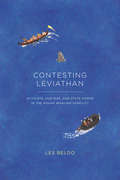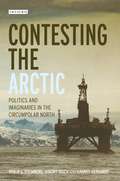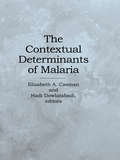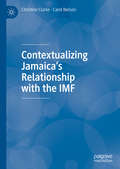- Table View
- List View
Contesting Leviathan: Activists, Hunters, and State Power in the Makah Whaling Conflict
by Les BeldoIn 1999, off the coast of the Pacific Northwest, the first gray whale in seven decades was killed by Makah whalers. The hunt marked the return of a centuries-old tradition and, predictably, set off a fierce political and environmental debate. Whalers from the Makah Indian Tribe and antiwhaling activists have clashed for over twenty years, with no end to this conflict in sight. In Contesting Leviathan, anthropologist Les Beldo describes the complex judicial and political climate for whale conservation in the United States, and the limits of the current framework in which whales are treated as “large fish” managed by the National Marine Fisheries Service. Emphasizing the moral dimension of the conflict between the Makah, the US government, and antiwhaling activists, Beldo brings to light the lived ethics of human-animal interaction, as well as how different groups claim to speak for the whale—the only silent party in this conflict. A timely and sensitive study of a complicated issue, this book calls into question anthropological expectations regarding who benefits from the exercise of state power in environmental conflicts, especially where indigenous groups are involved. Vividly told and rigorously argued, Contesting Leviathan will appeal to anthropologists, scholars of indigenous culture, animal activists, and any reader interested in the place of animals in contemporary life.
Contesting the Arctic: Politics and Imaginaries in the Circumpolar North (International Library of Human Geography)
by Philip E. Steinberg Jeremy Tasch Hannes Gerhardt Adam Keul Elizabeth A. NymanAs climate change makes the Arctic a region of key political interest, so questions of sovereignty are once more drawing international attention. The promise of new sources of mineral wealth and energy, and of new transportation routes, has seen countries expand their sovereignty claims. Increasingly, interested parties from both within and beyond the region, including states, indigenous groups, corporate organizations, and NGOs and are pursuing their visions for the Arctic. What form of political organization should prevail? Contesting the Arctic provides a map of potential governance options for the Arctic and addresses and evaluates the ways in which Arctic stakeholders throughout the region are seeking to pursue them.
Contextual Approach to Quantum Formalism (Fundamental Theories of Physics #160)
by Andrei Y. KhrennikovThe aim of this book is to show that the probabilistic formalisms of classical statistical mechanics and quantum mechanics can be unified on the basis of a general contextual probabilistic model. By taking into account the dependence of (classical) probabilities on contexts (i.e. complexes of physical conditions), one can reproduce all distinct features of quantum probabilities such as the interference of probabilities and the violation of Bell’s inequality. Moreover, by starting with a formula for the interference of probabilities (which generalizes the well known classical formula of total probability), one can construct the representation of contextual probabilities by complex probability amplitudes or, in the abstract formalism, by normalized vectors of the complex Hilbert space or its hyperbolic generalization. Thus the Hilbert space representation of probabilities can be naturally derived from classical probabilistic assumptions. An important chapter of the book critically reviews known no-go theorems: the impossibility to establish a finer description of micro-phenomena than provided by quantum mechanics; and, in particular, the commonly accepted consequences of Bell’s theorem (including quantum non-locality). Also, possible applications of the contextual probabilistic model and its quantum-like representation in complex Hilbert spaces in other fields (e.g. in cognitive science and psychology) are discussed.
The Contextual Determinants of Malaria
by Elizabeth A. Casman Hadi DowlatabadiAs malaria and other tropical diseases continue their resurgence, questions about the potential impacts of environmental and demographic factors are becoming more critical. Recent attempts to understand the increase in malaria incidence often acknowledge the importance of social, economic and other contextual variables, but fail to explicitly incorporate them into models or consider how they evolve in relation to one another. This problem is of crucial interest to the climate policy community, which has been buffeted by claims and counter-claims concerning the impact of climate change on malaria. This important volume examines the contextual determinants of malaria and attempts to develop methods for incorporating them into projections of future incidence. Internationally renowned health specialists, economists, and other social scientists provide regional and global perspectives on risk modeling, the history of eradication efforts, current determinants (including environmental, social, and economic factors), and prospects for new vaccines and drugs. The Contextual Determinants of Malaria argues that an association of climate change with increased malaria incidence will have at least as much to do with human aging, poverty, urbanization, and population movement as with a rise in global temperatures. By placing climate in this perspective, The Contextual Determinants of Malaria focuses attention on the public health needs most critical in both the immediate and long-term future. It encourages multidisciplinary analysis of malaria control, and improves our understanding of the interactions of the diverse range of factors involved in the incidence and spread of the disease.
The Contextual Determinants of Malaria
by Elizabeth A. Professor Casman Hadi Professor DowlatabadiAs malaria and other tropical diseases continue their resurgence, questions about the potential impacts of environmental and demographic factors are becoming more critical. Recent attempts to understand the increase in malaria incidence often acknowledge the importance of social, economic and other contextual variables, but fail to explicitly incorporate them into models or consider how they evolve in relation to one another. This problem is of crucial interest to the climate policy community, which has been buffeted by claims and counter-claims concerning the impact of climate change on malaria. This important volume examines the contextual determinants of malaria and attempts to develop methods for incorporating them into projections of future incidence. Internationally renowned health specialists, economists, and other social scientists provide regional and global perspectives on risk modeling, the history of eradication efforts, current determinants (including environmental, social, and economic factors), and prospects for new vaccines and drugs. The Contextual Determinants of Malaria argues that an association of climate change with increased malaria incidence will have at least as much to do with human aging, poverty, urbanization, and population movement as with a rise in global temperatures. By placing climate in this perspective, The Contextual Determinants of Malaria focuses attention on the public health needs most critical in both the immediate and long-term future. It encourages multidisciplinary analysis of malaria control, and improves our understanding of the interactions of the diverse range of factors involved in the incidence and spread of the disease.
Contextual Heterogeneity in Entrepreneurship Research: Frontiers in European Entrepreneurship Research (Frontiers in European Entrepreneurship series)
This insightful book explores the importance and influence of contextual heterogeneity in the field of entrepreneurship research, illuminating the circumstances, conditions or environments that may enable or constrain entrepreneurship. Expert contributors present the results of empirical studies in a wide variety of contexts, describing their depth and meaning both for entrepreneurship research and practice. Chapters illustrate a range of topics and research methods, including business model innovation in start-up companies, the challenges and opportunities for women entrepreneurs in STEM, and the use of technology signalling in explaining the performance of immigrant entrepreneurship in market economies. Presenting new scientific evidence in the field, together with research-informed policy and practical implications, the book demonstrates that a multitude of research approaches must be used to reflect the multi-dimensional nature of context in entrepreneurship. Warning against simplistic interpretations and superficial conclusions of research, this book will prove to be an invaluable resource for scholars and students of entrepreneurship. Its use of empirical studies will also be beneficial for practitioners in this field.
Contextualizing Disaster (Catastrophes in Context #1)
by Gregory V. Button Mark SchullerContextualizing Disaster offers a comparative analysis of six recent "highly visible" disasters and several slow-burning, "hidden," crises that include typhoons, tsunamis, earthquakes, chemical spills, and the unfolding consequences of rising seas and climate change. The book argues that, while disasters are increasingly represented by the media as unique, exceptional, newsworthy events, it is a mistake to think of disasters as isolated or discrete occurrences. Rather, building on insights developed by political ecologists, this book makes a compelling argument for understanding disasters as transnational and global phenomena.
Contextualizing Disaster (Catastrophes in Context #1)
by Gregory V. Button and Mark SchullerContextualizing Disaster offers a comparative analysis of six recent "highly visible" disasters and several slow-burning, "hidden," crises that include typhoons, tsunamis, earthquakes, chemical spills, and the unfolding consequences of rising seas and climate change. The book argues that, while disasters are increasingly represented by the media as unique, exceptional, newsworthy events, it is a mistake to think of disasters as isolated or discrete occurrences. Rather, building on insights developed by political ecologists, this book makes a compelling argument for understanding disasters as transnational and global phenomena.
Contextualizing Jamaica’s Relationship with the IMF
by Christine Clarke Carol NelsonThis ambitious book provides a comprehensive quantitative and qualitative assessment of Jamaica’s ties to the International Monetary Fund, focusing on Jamaica’s historical relationship with the IMF and reflecting on the domestic and international discourse surrounding the evolution of this relationship. Notably, this volume presents a critical analysis of Jamaica’s first engagement with and departure from the IMF and interrogates the political economy of the period. Jamaica’s economic experiences are assessed in the context of major global events, including the food price crises of 2007 and the global economic crises of 2008 and 2009. This book also looks at policy implications, and its well-researched analysis will be of great value to practitioners and policymakers as well as academics.
Continental Drift: Colliding Continents, Converging Cultures
by Constantin RomanContinental Drift: Colliding Continents, Converging Cultures is as much an account of the impressions Western culture made on Constantin Roman as a young researcher from behind the Iron Curtain as a personal history of the developing new science of plate tectonics. The book elucidates the author's struggles against a web of bureaucracy to secure hi
Continental Drift (large print)
by RnibThere are two maps on this page showing how the continents of South America and Africa were once joined and have now drifted apart. There is a locator dot shown, which will be at the top left of the page when the image is the correct way up. A light dashed horizontal line separates the two maps. At the top of the page the locations of the continents are shown as they were 500 million years ago. South America on the left and Africa on the right are shown almost touching and seem to fit neatly together. In the centre of the image, the areas of rock and the fossils found in them match each other on both continents. In the map at the bottom of the page, the continents' present locations are shown; they have drifted away from each other and are now almost 2000 miles apart.
Continental Drift, Secular Motion of the Pole, and Rotation of the Earth (International Astronomical Union Symposia #32)
by Wm. Markowitz B. GuinotAGU American Geophysical Union BIH Bureau International de l'Heure FAGS Federation of Astronomical and Geophysical Services lAG International Association of Geodesy IAU International Astronomical Union ICSU International Council of Scientific Unions ILS International Latitude Service IPMS International Polar Motion Service International Union of Geodesy and Geophysics IUGG PZT Photographic Zenith Tube UNESCO United Nations Educational, Scientific and Cultural Organization INTRODUCTION The hypothesis of continental drift has become of increasing interest to geophysicists in recent years. The IUGG Upper Mantle Committee has stated that the hypothesis of continental drift envisages horizontal displacements of the continents over th- sands of kilometers, and that it is a principal objective of the Upper Mantle Project to prove whether or not continental drift has occurred. The origin of the hypothesis may be traced to the close similarity in outlines of the coasts on the two sides of the Atlantic Ocean. The theory that the eastern and western hemispheres are drifting apart was expounded in particular by A. Wegener. Modern geophysical theories seek to explain paleomagnetic observations by - suming that two things have occurred in the past: (a) large-scale polar wandering, and (b) continental drift. A direct confirmation of drift, if it exists, is greatly desired. Attempts have been made to prove that continental drift has occurred from - served changes in latitude and longitude. It was thought by some, in fact, that such changes had been detected.
Continental Drift (UEB contracted)
by RnibThere are two maps on this page showing how the continents of South America and Africa were once joined and have now drifted apart. There is a locator dot shown, which will be at the top left of the page when the image is the correct way up. A light dashed horizontal line separates the two maps. At the top of the page the locations of the continents are shown as they were 500 million years ago. South America on the left and Africa on the right are shown almost touching and seem to fit neatly together. In the centre of the image, the areas of rock and the fossils found in them match each other on both continents. In the map at the bottom of the page, the continents' present locations are shown; they have drifted away from each other and are now almost 2000 miles apart.
Continental Drift (UEB uncontracted)
by RnibThere are two maps on this page showing how the continents of South America and Africa were once joined and have now drifted apart. There is a locator dot shown, which will be at the top left of the page when the image is the correct way up. A light dashed horizontal line separates the two maps. At the top of the page the locations of the continents are shown as they were 500 million years ago. South America on the left and Africa on the right are shown almost touching and seem to fit neatly together. In the centre of the image, the areas of rock and the fossils found in them match each other on both continents. In the map at the bottom of the page, the continents' present locations are shown; they have drifted away from each other and are now almost 2000 miles apart.
Continental Evolution: Structure, Stratigraphy, and Tectonics of the Africa-Atlantic-Mediterranean Triple Junction (Lecture Notes in Earth Sciences #116)
by André Michard Omar Saddiqi Ahmed Chalouan Dominique Frizon De LamotteMorocco is one of the most fascinating lands in the world from the point of view of its geological structure and evolution. Our knowledge on the geology of the country has been greatly improved during the last decades, based on numerous seismic profiles and boreholes, seismological analysis of focal mechanisms, seismic tomography, gravimetric/geodetic modelling and, on the other hand, based on a big National Program of Geological Mapping including modern geochemical analyses (trace elements) and reliable isotopic datings (39Ar-40Ar, U-Pb zircon, Sm-Nd, etc). Moreover, a number of academic studies have been performed in relation with the increasing number of Moroccan universities. Accordingly, there was an utmost urgency to undertake a new treatise of Moroccan geology which could substitute for the classical Eléments de géologie marocaine, published in 1976 by A. Michard in the Notes et Mémoires du Service géologique du Maroc (re-edited twice since 1976, with more than 6000 copies sold, and… translated in Japanese for engineers!). A new treatise has been prepared between April 2006 and July 2007 under the coordination of A. Michard, assisted by O. Saddiqi, and A. Chalouan, by a wide panel of authors from Morocco, France or Belgium among the best connoisseurs of the country. In order to emphasize the general interest of the book, we finally retain the following title: Continental Evolution: The Geology of Morocco. Structure, Stratigraphy, and Tectonics of the Africa-Atlantic-Mediterranean Triple junction. The editing and production of this book was supported by the following organisations: The Geological Society of France (SGF) The National Office of Hydrocarbons and Mines of Morocco (ONHYM) The International Lithosphere Program (ILP)
Continental Margin Sedimentation: From Sediment Transport to Sequence Stratigraphy (International Association Of Sedimentologists Series #25)
by Charles A. Nittrouer James A. Austin Michael E. Field Joseph H. Kravitz Patricia L. Wiberg James P. M. SyvitskiThis volume on continental margin sedimentation brings together an expert editorial and contributor team to create a state-of-the-art resource. Taking a global perspective, the book spans a range of timescales and content, ranging from how oceans transport particles, to how thick rock sequences are formed on continental margins. Summarizes and integrates our understanding of sedimentary processes and strata associated with fluvial dispersal systems on continental shelves and slopes Explores timescales ranging from particle transport at one extreme, to deep burial at the other Insights are presented for margins in general, and with focus on a tectonically active margin (northern California) and a passive margin (New Jersey), enabling detailed examination of the intricate relationships between a wide suite of sedimentary processes and their preserved stratigraphy Includes observational studies which document the processes and strata found on particular margins, in addition to numerical models and laboratory experimentation, which provide a quantitative basis for extrapolation in time and space of insights about continental-margin sedimentation Provides a research resource for scientists studying modern and ancient margins, and an educational text for advanced students in sedimentology and stratigraphy
The Continental Permain in Central, West, and South Europe: Proceedings of the NATO Advanced Study Institute held at the Johannes Gutenberg University, Mainz, F.R.G., 23 September – 4 October, 1975 (Nato Science Series C: #22)
by H. FalkeGeological research on the continental Permian in West Central and South Europe has been neglected in l l former days. Nevertheless, interest in it increased in the last twenty years and became important owing to the problems connected with continental sedimentation and also because of the important discoveries of oill gas and uranium deposits. Therefore, detailed inves l tigations in all countries where continental Permian appears have been made with the help of boreholes. These investigations included sedimentation basins in which the above-mentioned deposits are not expected. Consequently, the numerous results received in connec tion with still unanswered questions led to the idea to invite the specialists to a meeting. The first meeting was held in Pisa 1966 and a further one in 1 Vienna 1969. Both conferences exclusively dealed with the deposits of the Verrucano province, both in the Alps and Apennines. With respect to the importance of such meetings a further one was intended to be arranged in Mainz dealing with the whole continental Permian in West Central, and South Europe. With financial help l of the,NATO Scientific Affairs Division this meeting could be arranged as a NATO Advanced Study Institute.
A Continental Plate Boundary: Tectonics at South Island, New Zealand (Geophysical Monograph Series #175)
by David Okaya Tim Stern Fred DaveyPublished by the American Geophysical Union as part of the Geophysical Monograph Series, Volume 175.A Continental Plate Boundary offers in one place the most comprehensive, up-to-date knowledge for researchers and students to learn about the tectonics and plate dynamics of the Pacific-Australian continental plate boundary in South Island and about the application of modern geological and geophysical methods. It examines what happens when convergence and translation occur at a plate boundary by Describing the geological and geophysical signature of a continental transform fault; Identifying the diverse vertical and lateral patterns of deformation at the plate boundary; Assessing an apparent seismicity gap on the plate boundary fault and fast-moving plate motions; Comparing this plate boundary to other global convergent continental strike-slip plate boundaries; Documenting the utility of the double-sided, onshore-offshore seismic method for exploration of a narrow continental island; and Providing additional papers presenting previously unpublished results. This volume will prove invaluable for seismologists, tectonophysicists, geodesists and potential-field geophysicists, geologists, geodynamicists, and students of the deformation of tectonic plates.
A Continental Plate Boundary: Tectonics at South Island, New Zealand (Geophysical Monograph Series #175)
by David Okaya Tim Stern Fred DaveyPublished by the American Geophysical Union as part of the Geophysical Monograph Series, Volume 175.A Continental Plate Boundary offers in one place the most comprehensive, up-to-date knowledge for researchers and students to learn about the tectonics and plate dynamics of the Pacific-Australian continental plate boundary in South Island and about the application of modern geological and geophysical methods. It examines what happens when convergence and translation occur at a plate boundary by Describing the geological and geophysical signature of a continental transform fault; Identifying the diverse vertical and lateral patterns of deformation at the plate boundary; Assessing an apparent seismicity gap on the plate boundary fault and fast-moving plate motions; Comparing this plate boundary to other global convergent continental strike-slip plate boundaries; Documenting the utility of the double-sided, onshore-offshore seismic method for exploration of a narrow continental island; and Providing additional papers presenting previously unpublished results. This volume will prove invaluable for seismologists, tectonophysicists, geodesists and potential-field geophysicists, geologists, geodynamicists, and students of the deformation of tectonic plates.
Continental Rift Formation and its Prehistory
by A.V. RazvalyaevTranslation of the Russian edition of 1988 on peculiarities of the Arabian-Nubian Shield in the Precambrian, prerift magmatism in the Red Sea Rift zone, evolution of the crust in rift forming zones.
Continental Rift Formation and its Prehistory
by A.V. RazvalyaevTranslation of the Russian edition of 1988 on peculiarities of the Arabian-Nubian Shield in the Precambrian, prerift magmatism in the Red Sea Rift zone, evolution of the crust in rift forming zones.
Continental Rifted Margins 1: Definition and Methodology (PDF)
by Gwenn Peron-PinvidicContinental Rifted Margins 1
Continental Rifted Margins 1: Definition and Methodology
by Gwenn Peron-PinvidicRifted margins mark the transition between continents and oceans, which are the two first-order types of land masses on Earth. Rifted margins contribute to our understanding of lithospheric extensional processes and are studied by various disciplines of Earth Science (geology, geophysics, geochemistry). Thanks to better and wider public access to high-quality data, our understanding in these areas has improved significantly over these last two decades.This book summarizes this knowledge evolution and details where we stand today, with a series of case examples included. It is structured in a practical way, with concise text descriptions and comprehensive diagrams. Continental Rifted Margins 1 is a useful resource for students and newcomers to the rifted margin community - a "cookbook" of sorts to facilitate the reading of scientific publications and provide basic definitions and explanations.

















